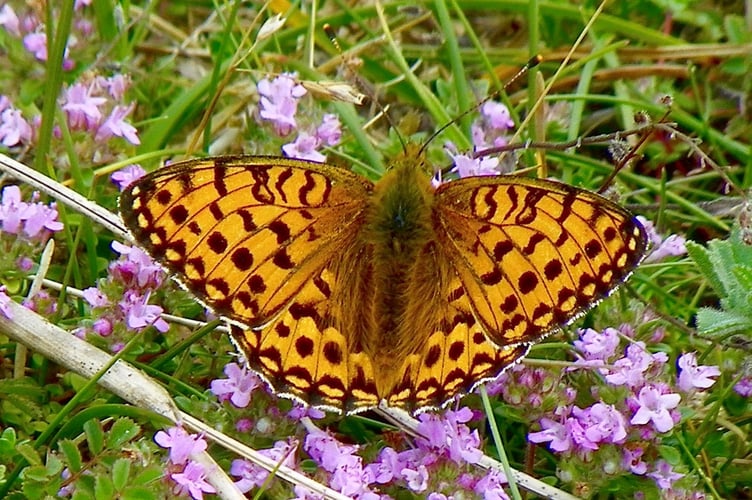Many island residents are reporting having seen fewer butterflies in their garden this year.
Should we be concerned? Local naturalist and Manx butterfly enthusiast Garry Curtis believes we shouldn’t be worried just yet - and here explains why not.
A lot of people are commenting that butterflies appear to be few and far between this year. And to a certain extent that’s true. But should we be worried?
In my opinion the simple answer is no, even with one species crashing in number, and I’ll try to explain why.
I suppose I should say at the outset that my views differ to many other wildlife enthusiasts. There seems to me to be an obsession with counting and recording things, as if somehow that is going to save our wildlife.
To me wildlife in all of its forms has evolved down tens of millions of years and all it really needs is somewhere to live. A simple concept but true. It’s just that humans are constantly reducing the available habitat. If we increase our population to 100,000, as is currently proposed, that cannot have anything other than an adverse impact in this regard.
Another aspect where my views differ is on what makes a good butterfly year? Say 2024 is a year when adult numbers are down but those butterflies have a very good breeding season. Then in 2025 numbers may be higher due to the 2024 breeding success. But if those 2025 larger numbers have a poor breeding season then 2026 numbers might be down on 2025.
In other words should we measure a butterfly season purely on adult butterflies? I have a very simple answer to that and that is that I don’t adopt the concept of there being a ‘good, average or bad butterfly year’. Numbers always have, and always will, fluctuate.
I should also say that butterfly numbers in general have followed the trend of most insect species and are a fraction of those found several decades ago.
Most of the comments currently being made relate to the absence of butterflies from gardens, and especially on the butterfly bush (buddleia) which many people grow specifically to attract butterflies. But, while there are exceptions, out of our 20 species there are only seven which regularly appear on buddleia and this year the most notable absentees are Small Tortoiseshell, Peacock and Red Admiral.
The most likely reason for the current low numbers of Small Tortoiseshell and Peacock are the weather conditions we’ve all been complaining about. Almost constant wind with a good few ‘sprinkles’ of rain.
These two species have similar life histories and requirements. They hibernate as adult butterflies and emerge in early spring to feed, mate and commence egg laying on beds of stinging nettle. In mid to late summer their progeny emerge to adorn our buddleias. Peacocks then go on to hibernate, as do a proportion of Small Tortoiseshells, whereas the remainder of the latter go on to produce a second brood which emerges in late August/early September.
Both species have emerged later than usual this summer and so it is possible that a higher proportion of Small Tortoiseshells will enter hibernation without producing a second brood. Time will tell.
As I write this article the first summer Peacock in my garden has appeared on my buddleia this morning (August 2).
Red Admirals migrate here annually in early spring and so their numbers depend almost completely on the number of individuals arriving. These early arrivals go on to breed throughout the summer and early autumn and consequently numbers are always at their highest in September when they take advantage of flowering ivy as their main source of nectar.
Painted Ladies are also an annual migrant and, apart from exceptional years such as 2019, are always in lower numbers than Red Admiral.
Having covered the species which are significantly lower in number this year it’s only right that I balance it out with those ‘buddleia users’ that are holding their own - Comma, Small White and Large White.
Commas are emerging now and are usually found in no more than ones or twos. Small White and Large White numbers build throughout the season, taking advantage of cultivated brassicas and nasturtiums on which to lay their eggs.
Then we come to the species which are not generally garden dwellers, although most do appear in mine on occasion. They also tend to go unnoticed. These include Small Copper, Holly Blue, Common Blue, Small Heath, Meadow Brown, Grayling, Speckled Wood, Green-veined White, Orange Tip and Dark Green Fritillary.
All of these have been reported widely this year although the latter two in reduced numbers. But I don’t regard that as a concern in the short term.
There are two species which are perhaps in their own categories – Clouded Yellow and Brimstone. The Clouded Yellow is a migrant which doesn’t reach our shores every year and as far as I know hasn’t been seen so far this year. Sightings normally occur between August and October.
-by-David-Radcliffe.jpg?trim=331,0,332,0&width=752&height=500&crop=752:500)
The Brimstone is newly established and if its caterpillar foodplant, alder buckthorn, is more widely grown it may become a much more familiar sight.
And finally, at the outset I mentioned a species that is crashing in number – the Wall. This species has undergone a dramatic decline across Britain and is considered to be on the brink of extinction in Northern Ireland. It was once common and widespread across the island and up to 2019 bred in my garden here in Andreas.
This year it has been reported mainly from coastal areas such as Marine Drive and Langness. Up to 2019 it bred in my Andreas garden every year. This year is the first where I haven’t a single one anywhere before the end of July.
Am I concerned or worried about the Wall? The honest answer is ‘No, I’m not’. Yes, I’d be dismayed to see them disappear from the island but my simple reasoning is that I can’t do anything about it. The decline has been sudden and is thought to be related to climate change.
I could rear and release hundreds but that wouldn’t affect the eventual outcome. It really is a case of wait and see.
On a positive note, which perhaps gives hope for the Wall, there have been big variations in numbers of some species over my lifetime. I didn’t see a Holly Blue or Peacock here until I was in my 30s and now both are common and widespread. Comma and Speckled Wood are relatively recent arrivals (1987 and 2005 respectively) and have thrived.
The Small Tortoiseshell underwent a huge decline earlier this century to a nadir in 2017-2018 and has bounced back although not to the levels previously seen.
My message is simple – it’s all about habitat and so we need to protect as much of our wild areas as we can. And there are occasionally opportunities to create new habitats.
In recent times there have been several really good nature reserves created, all now with plenty of butterflies. Poyll Dooey in Ramsey, Ballanette at Lonan and Laxey Salmon Centre are all former landfill tips, the latter two reserves being created by Stewart Clague. And there is the Manx Wildlife Trust’s Ballachurry reserve at Rushen.

You can keep track of where and what can be seen via the Facebook page ‘Manx Butterflies’. You can post your photos and sightings there too, or ask qustions. All sightings of Wall would be most appreciated.
And if you have any questions or want further information you can email me direct – [email protected].


.jpg?width=209&height=140&crop=209:145,smart&quality=75)

